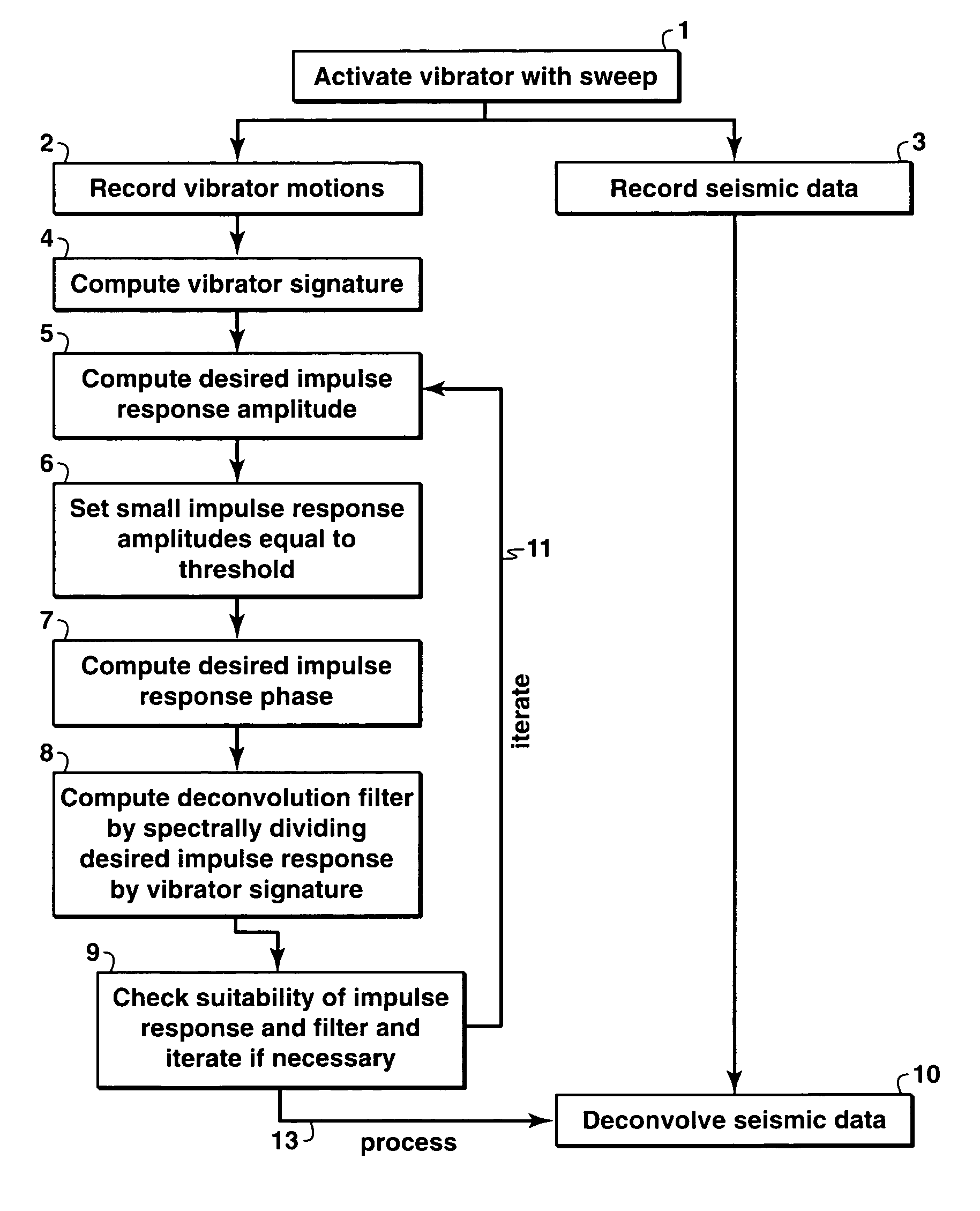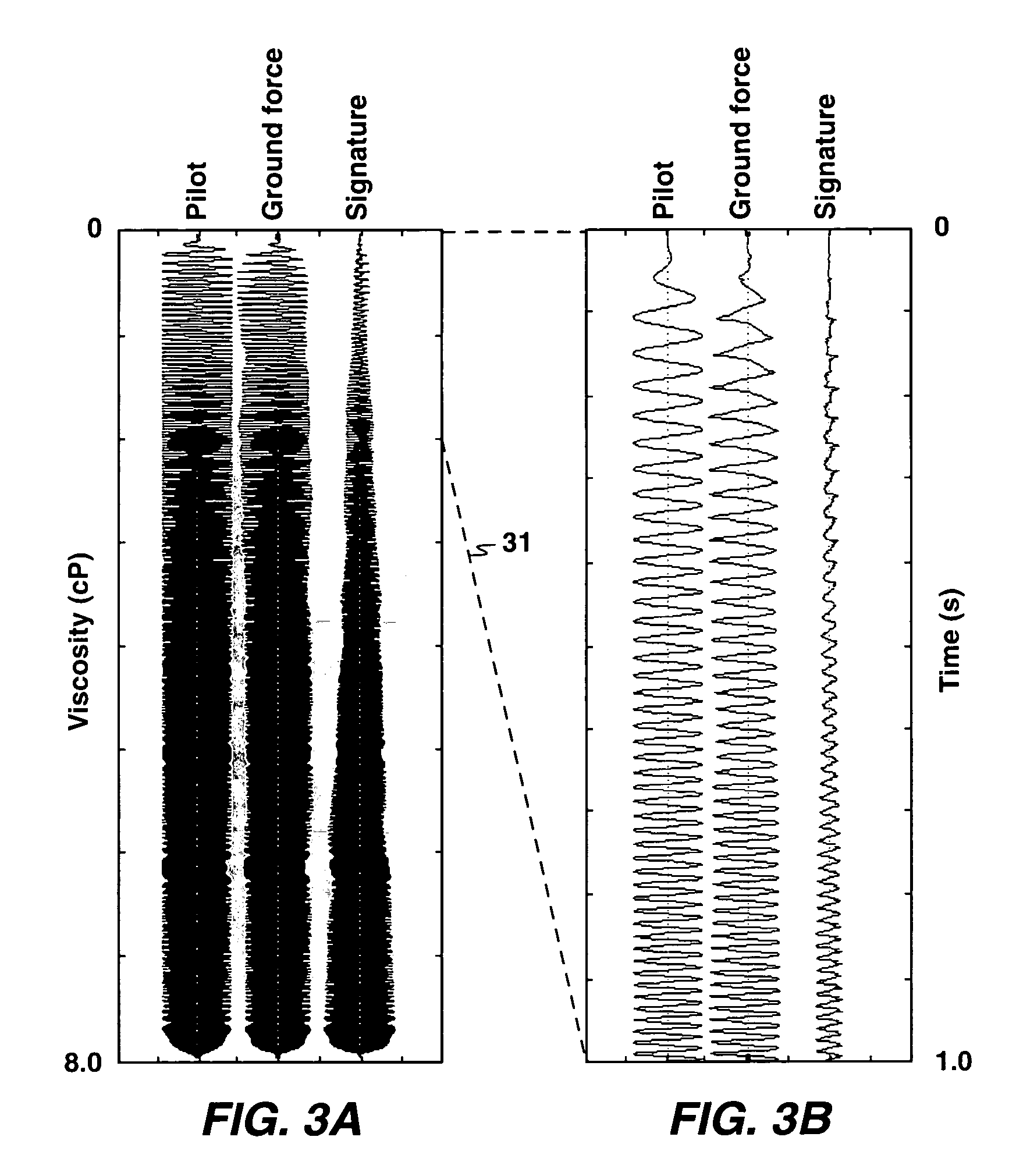Shaped high frequency vibratory source
a high-frequency, vibratory source technology, applied in the field of seismic data acquisition and processing of seismic source data, can solve the problems of no longer causal data, no well-defined arrival time, and undesirable pulse characteristics, and achieve the effect of improving noise suppression
- Summary
- Abstract
- Description
- Claims
- Application Information
AI Technical Summary
Benefits of technology
Problems solved by technology
Method used
Image
Examples
third embodiment
[0037] In a third embodiment, the method of the present invention facilitates processing to be applied for separating the data from each vibrator into individual records. Static corrections and differential normal moveout (NMO) can then be applied to each source location. In addition, supergathers can be constructed which improve the capabilities of noise separation techniques. The data from each source location can be summed. Alternatively, data can be binned at smaller common depth point intervals prior to migration, thereby further improve imaging and focusing.
[0038] Embodiments of the present invention will be discussed in the following in association with the system diagram of FIG. 1, which depicts the geometry of the data gathering system associated with the present invention. In FIG. 1, vibrators 18, 20, 22, and 24 are located, in an on-land application, on trucks 34, 36, 38, and 40, respectively. Signals that are generated in the earth by vibrators 18, 20, 22, and 24 are ref...
first embodiment
[0039] the method of the present invention, as depicted in the flow chart of FIG. 2, begins with the activation of one or more vibrators with a sweep, step 1. Next, vibrator motions, step 2 and seismic data, step 3 are both recorded. Third, a vibrator signature is computed from the measured vibrator motions, step 4. Next, a desired impulse response is computed. This involves the specification of a desired impulse response amplitude spectrum, step 5 which is preferably less than or equal to the vibrator signature spectrum at all frequencies. Preferably, the amplitudes of the impulse response and the vibrator signature that fall below a small threshold value are set equal to the threshold value, step 6. Alternatively, a small amount of prewhitening noise can be added at all frequencies (Not depicted in FIG. 1). Next, a desired phase for the impulse response is calculated, step 7. A deconvolution filter is computed by spectrally dividing the calculated impulse response by the vibrator ...
second embodiment
[0057] In the present invention, a vibrator signature deconvolution is performed within a matrix separation scheme for a number of vibrators operated simultaneously. In this embodiment, a plurality of vibrators is then employed to perform a number of sweeps. The number of sweeps should be equal to or greater than the number of vibrators. Measurements are made of both the motions of the vibrators and the received seismic signals. Next, vibrator signatures are computed, with the amplitudes clipped at a minimum threshold value. A desired impulse response is constructed next, as described above. A deconvolution matrix operator is generated in the frequency domain that separates the earth response for each vibrator and replaces the individual vibrator signatures with the desired impulse response. That operator is applied to deconvolve the seismic data and to separate that data according to the individual vibrator locations.
[0058] In this second embodiment, multiple sweeps, in a number eq...
PUM
 Login to View More
Login to View More Abstract
Description
Claims
Application Information
 Login to View More
Login to View More - R&D
- Intellectual Property
- Life Sciences
- Materials
- Tech Scout
- Unparalleled Data Quality
- Higher Quality Content
- 60% Fewer Hallucinations
Browse by: Latest US Patents, China's latest patents, Technical Efficacy Thesaurus, Application Domain, Technology Topic, Popular Technical Reports.
© 2025 PatSnap. All rights reserved.Legal|Privacy policy|Modern Slavery Act Transparency Statement|Sitemap|About US| Contact US: help@patsnap.com



